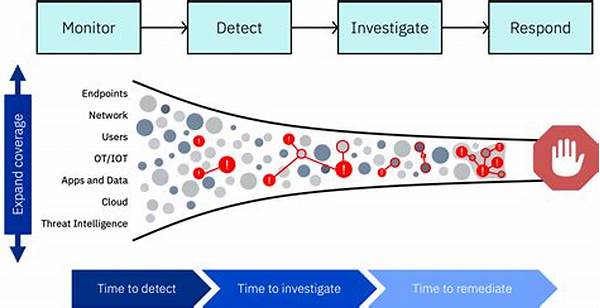In the contemporary digital landscape, the escalation of cyber threats necessitates sophisticated approaches for threat analysis. One such approach is the employment of machine learning for threat analysis. This technology enables the identification of potential threats in real-time, allowing organizations to preemptively mitigate risks. As cyberattacks become increasingly complex, machine learning continues to prove invaluable in deciphering patterns and anomalies that may signify an impending threat. By rigorously analyzing vast datasets, machine learning algorithms can detect subtleties that humans might overlook. The integration of machine learning into threat analysis frameworks enhances security protocols, offering a robust mechanism to shield sensitive information.
The Role of Machine Learning in Threat Analysis
The role of machine learning for threat analysis is pivotal as it leverages vast amounts of data to identify and predict cybersecurity threats. In the context of threat analysis, machine learning models are trained to recognize complex patterns within multifaceted data structures. Importantly, these algorithms not only detect known threats but also possess the capability to anticipate novel threats. As a result, organizations benefit from proactive threat detection, reducing the window of vulnerability.
Machine learning empowers analysts by reducing manual oversight and error probability through self-learning models that enhance over time. Such models can process data at a speed and scale unattainable by manual methods, thereby offering timely insights crucial for threat mitigation. The dynamic adaptability of machine learning algorithms allows for continuous updates, ensuring the models remain effective in a constantly evolving cyber environment. Moreover, the technology supports the development of automated responses to identified threats, further enhancing operational efficiency.
Benefits of Machine Learning for Threat Analysis
1. Real-Time Detection: Machine learning for threat analysis facilitates real-time detection of potential cyber threats, enabling rapid response and mitigation strategies.
2. Scalability: The ability of machine learning models to process large volumes of data offers scalability, essential for handling the increasing number of cyber threats.
3. Pattern Recognition: Advanced pattern recognition offered by machine learning helps in identifying both known and unknown threats, providing a comprehensive security solution.
4. Automated Analysis: The automation of threat analysis through machine learning reduces the need for manual inspection, allowing human resources to focus on strategic security initiatives.
5. Continuous Improvement: Machine learning models learn from new data, improving over time, which increases the accuracy and reliability of threat detection.
Challenges in Implementing Machine Learning for Threat Analysis
Implementing machine learning for threat analysis is not without challenges. One significant hurdle is the quality and volume of data required to train effective models. High-quality, representative datasets are essential for the accuracy and reliability of threat detection through machine learning. Furthermore, the complexity of cybersecurity data necessitates sophisticated preprocessing techniques to ensure data validity before feeding it into machine learning models.
Another challenge lies in the interpretability of machine learning algorithms. Often, the decisions made by machine learning models lack transparency, making it difficult for analysts to understand the reasoning behind certain threat identifications. This opacity can hinder trust in machine learning systems and requires supplementary tools for insight clarification. Additionally, the deployment of machine learning for threat analysis must consider potential adversarial tactics designed to deceive or manipulate machine learning models, safeguarding them against obfuscation attempts.
Future Prospects of Machine Learning for Threat Analysis
The future of machine learning for threat analysis seems promising as technological advancements continue to reshape cybersecurity landscapes. As machine learning algorithms become more sophisticated, their integration into threat analysis is projected to enhance predictive capabilities significantly. Researchers are continually developing novel methodologies, such as deep learning models, which can offer even greater accuracy and efficacy in threat detection and prevention.
Additionally, the synergy of machine learning with other emerging technologies like artificial intelligence and blockchain is anticipated to further fortify threat analysis frameworks. These integrations provide heightened security measures, offering comprehensive protection against a diverse array of cyber threats. As machine learning evolves, its role in preemptively identifying and neutralizing threats will become essential in maintaining secure digital environments for organizations worldwide.
Enhancing Cybersecurity with Machine Learning for Threat Analysis
The synergy between machine learning and threat analysis has revolutionized cybersecurity, ushering in a new era of enhanced protection mechanisms. By utilizing machine learning for threat analysis, organizations can implement a proactive defense strategy that anticipates vulnerabilities rather than merely reacting to them. This strategic forethought is essential for modern organizations which face an increasing frequency of sophisticated cyberattacks.
Machine learning algorithms help bridge the gap between detecting threats and responding to them. These algorithms, through continuous learning and adaptation, evolve alongside emerging threats, ensuring resilient cybersecurity infrastructure. Machine learning for threat analysis is not only a tool for identifying threats but also a critical component of a broader cybersecurity strategy aimed at safeguarding organizational assets and data integrity.
Summary of Machine Learning for Threat Analysis
In summary, machine learning for threat analysis represents a fundamental shift in how organizations approach cybersecurity. The application of machine learning expedites threat detection processes, transforming traditional reactive approaches to proactive stances. By enabling the swift identification of anomalies and potential threats, machine learning enhances operational security measures and mitigates risks associated with cyberattacks.
Furthermore, the ongoing development in machine learning technologies promises unparalleled advancements in threat analysis capabilities. These innovations are likely to redefine how real-time threat detection and prevention strategies are implemented, offering a level of precision and foresight previously unattainable. Ultimately, machine learning for threat analysis not only addresses current cybersecurity challenges but also paves the way for a more secure digital future.





